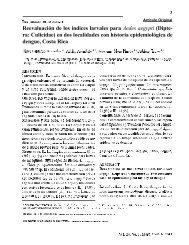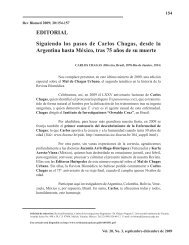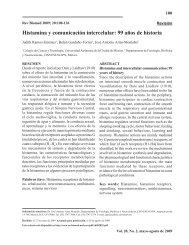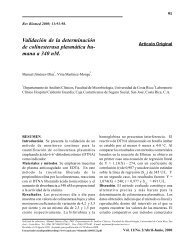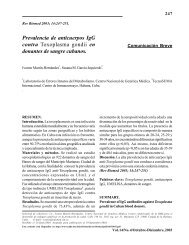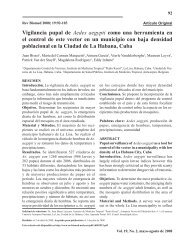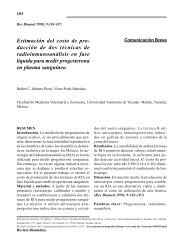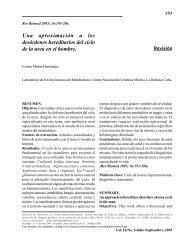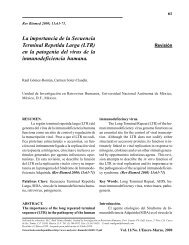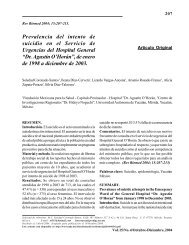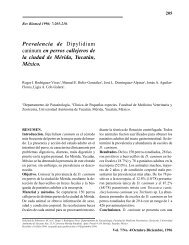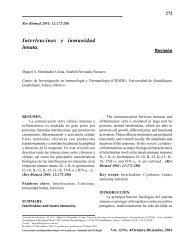Biochemical serum markers for Down syndrome screening. - Revista ...
Biochemical serum markers for Down syndrome screening. - Revista ...
Biochemical serum markers for Down syndrome screening. - Revista ...
Create successful ePaper yourself
Turn your PDF publications into a flip-book with our unique Google optimized e-Paper software.
259<br />
Rev Biomed 2005; 16:259-271.<br />
<strong>Biochemical</strong> <strong>serum</strong> <strong>markers</strong> <strong>for</strong><br />
<strong>Down</strong> <strong>syndrome</strong> <strong>screening</strong>.<br />
Review<br />
Ileana B. Baluja-Conde 1 , Maya R. Rodríguez-López 1 , Orlando Zulueta-Rodríguez 2 , Bertha Ruiz-<br />
Escandón 3 , Senia Bermúdez-Velásquez 3 .<br />
1<br />
Laboratorio de Anticuerpos Monoclonales, 2 Laboratorio de Purificaciones, 3 Departamento de<br />
In<strong>for</strong>mática, Centro de Inmunoensayo, Cubanacán Playa, Cuba.<br />
SUMMARY.<br />
<strong>Down</strong> <strong>syndrome</strong> is caused by an extra<br />
chromosome 21 and is the most common autosomal<br />
chromosome aberration in which affected<br />
individuals survive beyond infancy. <strong>Down</strong> <strong>syndrome</strong><br />
results in mental retardation and several congenital<br />
mal<strong>for</strong>mations.<br />
The overall prevalence of this disease varies<br />
from 1:40 to 1:900 births. The risk of carrying a<br />
<strong>Down</strong> <strong>syndrome</strong> fetus depends on various factors,<br />
and it increases almost exponentially with maternal<br />
age.<br />
The methods established <strong>for</strong> detecting the<br />
disease are based on testing the fetus, either<br />
directly, by invasive techniques, or indirectly, based<br />
upon indices of relative fetal development. Maternal<br />
<strong>serum</strong> <strong>screening</strong> is a non-invasive method. It relies<br />
on the measurements and quantification of multiple<br />
biochemical <strong>markers</strong> such as: alpha-fetoprotein<br />
(AFP), human chorionic gonadotropin (hCG), free<br />
b-hCG, unconjugated estriol, and inhibin-A. These<br />
concentrations increase or decrease depending on<br />
whether they belong to a fetus with this anomaly or<br />
not.<br />
We review the main characteristics of this<br />
disease, as well as the methods of detection used,<br />
and the biochemical <strong>serum</strong> <strong>markers</strong> <strong>for</strong> <strong>Down</strong><br />
<strong>syndrome</strong> <strong>screening</strong> with a higher reliability and<br />
detectability. (Rev Biomed 2005; 16:259-271)<br />
Key words: <strong>Down</strong> <strong>syndrome</strong>, AFP, hCG, free b-<br />
hCG, unconjugated estriol, inhibin-A.<br />
RESUMEN.<br />
Marcadores bioquímicos séricos para el<br />
tamizaje del síndrome de <strong>Down</strong>.<br />
El síndrome de <strong>Down</strong> es un desorden que<br />
implica una copia extra del cromosoma 21 y es la<br />
principal aneuploidía autosómica, en la cual los<br />
individuos afectados sobreviven más allá de la<br />
infancia. Se caracteriza por el retraso mental y varias<br />
mal<strong>for</strong>maciones congénitas.<br />
Corresponding address (Home): Dra. Ileana B. Baluja Conde, Dirección particular: Calle H # 18304 /1ra y 2da, Rpto. Monterrey, San<br />
Miguel del Padrón, La Habana, Cuba. Tel: (537) 910193 E-mail: ileanabalujaconde@yahoo.es<br />
Work address: Centro de Inmunoensayo, Calle 134 y Ave. 25, Cubanacán Playa, Cuba.<br />
Tel: (537) 2082929 E-mail: iqmonoclo1@cie.sld.cu<br />
Received February 22, 2005; Accepted July 6, 2005.<br />
This paper is also available at http://www.uady.mx/sitios/biomedic/revbiomed/pdf/rb051646.pdf<br />
Vol. 16/No. 4/Octubre-Diciembre, 2005
260<br />
IB Baluja-Conde, MR Rodríguez-López, O Zulueta-Rodríguez, B Ruiz-Escandón, et al.<br />
La prevalencia de esta enfermedad varía desde<br />
1:40 hasta 1:900 nacimientos. El riesgo de la<br />
embarazada de portar un feto con síndrome de <strong>Down</strong><br />
depende de varios factores, incrementándose éste<br />
a medida que aumenta la edad materna.<br />
Los métodos utilizados para detectar esta<br />
enfermedad se basan en pruebas realizadas al feto<br />
mediante técnicas invasivas o la medición de índices<br />
del desarrollo fetal mediante técnicas no invasivas.<br />
Los más empleados son la determinación y<br />
cuantificación en suero de varios marcadores<br />
bioquímicos tales como: la alfafetoproteína (AFP),<br />
la hormona gonadotropina coriónica humana<br />
(hCG), la subunidad b libre de la hCG, la inhibina-<br />
A y el estriol no conjugado, cuyas concentraciones<br />
aumentan o disminuyen dependendiendo de si<br />
corresponden o no a un feto con esta anomalía.<br />
En este artículo se revisan las características<br />
principales de esta enfermedad, los métodos de<br />
diagnóstico empleados y los marcadores<br />
bioquímicos presentes en el suero que ofrecen<br />
mayor confiabilidad y detectabilidad empleados en<br />
el tamizaje del síndrome de <strong>Down</strong>.<br />
(Rev Biomed 2005; 16:259-271)<br />
Palabras clave: síndrome de <strong>Down</strong>,<br />
alfafetoproteína, hCG, b-hCG libre, inhibina A,<br />
estriol no conjugado.<br />
INTRODUCTION.<br />
<strong>Down</strong> Syndrome (DS), or Trisomy 21, is the<br />
most common serious autosomal chromosome<br />
aberration in which affected individuals survive<br />
beyond infancy (1-3). It is the most frequent <strong>for</strong>m<br />
of mental retardation and is characterized by welldefined<br />
and distinctive phenotypic features and<br />
natural history. <strong>Down</strong> children have a widely<br />
recognized characteristic appearance. The head<br />
may be smaller than normal and abnormally shaped.<br />
Prominent facial features include a flattened nose,<br />
protruding tongue, and upward slanting eyes<br />
(Mongolian slant). The hands are short and broad<br />
with short fingers and often have a single palmar<br />
crease. Retardation of normal growth and<br />
<strong>Revista</strong> Biomédica<br />
development is typical, and most affected children<br />
never reach average adult height. The average<br />
mental age achieved is that of an 8 year old (2, 3).<br />
The severity of the <strong>syndrome</strong> includes congenital<br />
cardiac mal<strong>for</strong>mation, immune system disorders,<br />
gastro-intestinal mal<strong>for</strong>mation such as esophageal<br />
and duodenal atresia, and slow physical<br />
development (3).<br />
Human cells normally have 46 chromosomes<br />
which can be arranged in 23 pairs. These cells divide<br />
into two ways: mitosis and meiosis. Many errors can<br />
occur during cell division. An error in cell<br />
development results in <strong>for</strong>ty-seven chromosomes<br />
rather than the usual <strong>for</strong>ty-six. In meiosis, the pairs<br />
of chromosomes are supposed to split up and go to<br />
different spots in the dividing cell; this event is called<br />
"disjunction." However, occasionally one pair does<br />
not divide, and the whole pair goes to one spot. This<br />
means that in the resulting cells, one will have 24<br />
chromosomes and the other will have 22<br />
chromosomes. This accident is called "nondisjunction."<br />
If a sperm or egg with an abnormal number of<br />
chromosomes merges with a normal mate, the<br />
resulting fertilized egg will have an abnormal number<br />
of chromosomes. In DS, 95% of all cases are<br />
caused by this event: a cell has two 21 st<br />
chromosomes instead of one, so the resulting<br />
fertilized egg has three 21 st chromosomes. Hence<br />
the scientific name, trisomy 21. Roughly four percent<br />
have translocation, where the extra chromosome<br />
twenty-one is broken off and becomes attached to<br />
another chromosome. About one percent has<br />
mosaicism. These people have a mixture of cell lines,<br />
some of which have a normal set of chromosomes<br />
and others have a trisomy 21 (4, 5). In addition,<br />
DS gives rise to a variety of traits with variable<br />
expressivity and penetrance (6).<br />
The overall birth prevalence of DS is<br />
approximately 1 per 900 births (2, 5).<br />
The 21st chromosome and <strong>Down</strong> <strong>syndrome</strong>.<br />
Chromosomes are thread-like structures<br />
composed of DNA and other proteins. They are<br />
present in every cell of the body and carry the
261<br />
<strong>Biochemical</strong> <strong>markers</strong> <strong>for</strong> <strong>Down</strong> <strong>syndrome</strong>.<br />
genetic in<strong>for</strong>mation needed <strong>for</strong> that cell to develop.<br />
The chromosomes are the holders of the genes. In<br />
DS, the presence of an extra set of genes leads to<br />
over-expression of the involved genes, leading to<br />
an increased production of certain products (1). For<br />
most genes, their over-expresion has little effect due<br />
to the body’s regulation mechanisms of genes and<br />
their products. But the genes that cause DS appear<br />
to be exceptions. On trisomy 21, it has been found<br />
that only a small portion of the 21 st chromosome<br />
actually needs to be triplicated to get the effects<br />
seen in this serious disorder (5). This is called the<br />
<strong>Down</strong> <strong>syndrome</strong> critical region. The 21st<br />
chromosome may actually hold 200 to 250 genes<br />
(being the smallest chromosome in the body in terms<br />
of total number of genes); but it has been estimated<br />
that only 20 to 50 genes may eventually be included<br />
in the <strong>Down</strong> <strong>syndrome</strong> critical region (5).<br />
Genes that may have input into DS include:<br />
· Superoxide Dismutase (SOD1).<br />
· COLGA1- over-expression may be the<br />
cause of heart defects.<br />
· ETS2- over-expression may be the cause<br />
of skeletal abnormalities and/or leukaemia.<br />
· CAF1A- over-expression may be the cause<br />
of detrimental DNA synthesis.<br />
· Cystathione Beta Synthase (CBS)- disrupts<br />
metabolism and DNA repair.<br />
· DYRK- over-expression may be the cause<br />
of mental retardation.<br />
· CRYA1- over-expression may be the cause<br />
of cataracts.<br />
· GART- over-expression may be the cause<br />
of disrupted DNA synthesis and repair.<br />
· IFNAR- over-expression may interfere with<br />
the immune system as well as with other systems.<br />
Other genes that are also suspects include<br />
APP, GLUR5, S100B, TAM, PFKL, and a few<br />
others.<br />
Prenatal Screening <strong>for</strong> fetal <strong>Down</strong>’s<br />
Syndrome.<br />
It has been estimated that the cost to detect<br />
each case of fetal <strong>Down</strong> <strong>syndrome</strong> is much lower<br />
than the average cost of health care, education, and<br />
residential costs <strong>for</strong> such an individual. At present<br />
there is no <strong>screening</strong> test available which is capable<br />
of specifically detecting parental predisposition <strong>for</strong><br />
offspring with DS. The established methods of<br />
detection are there<strong>for</strong>e based on testing the fetus,<br />
either directly by invasive techniques or indirectly<br />
based on indices of relative fetal development.<br />
Amniocentesis is an invasive technique in which<br />
a sample of the amniotic fluid is removed from the<br />
uterus. This method is associated with approximately<br />
0.5-1 % increase in the risk of spontaneous abortion<br />
(7). It may be per<strong>for</strong>med between 14-16 weeks of<br />
gestation. Chorionic villus sampling (CVS) is<br />
another invasive procedure per<strong>for</strong>med in the first<br />
trimester (between 10-12 weeks of gestation),<br />
where a small piece of chorionic villus <strong>for</strong><br />
chromosomal analysis is withdrawn. CVS results<br />
approximately in a 1.5% increased risk of<br />
spontaneous fetal losses through 28 weeks of<br />
gestation (8, 9).<br />
Both CVS and amniocentesis may be used as<br />
prenatal diagnostic tests <strong>for</strong> <strong>Down</strong> <strong>syndrome</strong> and<br />
can conclusively determine its presence in the fetus<br />
with a high degree of reliability. The risk associated<br />
with invasive diagnostic procedures and the costs<br />
of the analyses preclude the adoption of these<br />
methods <strong>for</strong> mass <strong>screening</strong> of prenatal women (9).<br />
The risk of conceiving a fetus with DS is<br />
significantly related to maternal age. This risk<br />
increases almost exponentially with age.<br />
<strong>Down</strong> <strong>syndrome</strong> <strong>screening</strong> has been offered<br />
to pregnant women since the early 1980s. The first<br />
<strong>screening</strong> programs <strong>for</strong> DS relied upon<br />
amniocentesis offered only to women of 35 years<br />
of age or older, thus being a high risk population<br />
<strong>screening</strong> approach. However, using this approach<br />
only about 20 - 30% of all <strong>Down</strong> <strong>syndrome</strong><br />
pregnancies could be detected, because the majority<br />
of these children are born from women under 35<br />
years old. In spite of the higher risk of having DS<br />
babies in older mothers, about 80% of these babies<br />
are born from young women. By using the maternal<br />
Vol. 16/No. 4/Octubre-Diciembre, 2005
262<br />
IB Baluja-Conde, MR Rodríguez-López, O Zulueta-Rodríguez, B Ruiz-Escandón, et al.<br />
age of 35 years or older as the criteria <strong>for</strong> prenatal<br />
<strong>screening</strong>, most of the cases that occur in women<br />
under 35 years old remain undetected.<br />
Maternal <strong>serum</strong> <strong>screening</strong> is a non-invasive<br />
method. The objective of this <strong>screening</strong> is to reduce<br />
the proportion of women who have to undergo<br />
invasive diagnostic testing and, at the same time,<br />
increase the proportion of affected fetuses detected<br />
(10, 11). It relies upon the measurement of multiple<br />
biochemical <strong>markers</strong> (AFP, hCG, Ue3, free b-hCG,<br />
inhibin A, and pregnancy-associated plasma protein<br />
A (PAPP-A)), the calculation of the risk factor<br />
based on the parameters measured, and the<br />
mother’s age at the time of conception (12-18).<br />
Screening procedures vary from country to<br />
country. Controversy exists about the number of<br />
<strong>markers</strong> used and which combination yields the<br />
highest efficacy. Parental counselling is essential to<br />
insure in<strong>for</strong>med consent <strong>for</strong> further investigation and<br />
<strong>for</strong> any termination of pregnancy that may result.<br />
Several factors influence the accuracy of<br />
<strong>screening</strong> tests, including gestation dating method,<br />
maternal weight, number of fetuses, etc.<br />
<strong>Biochemical</strong> <strong>markers</strong> in maternal <strong>serum</strong><br />
<strong>for</strong> <strong>Down</strong> <strong>syndrome</strong> <strong>screening</strong>.<br />
The sensitivity and specificity of prenatal<br />
<strong>screening</strong> <strong>for</strong> DS have improved in recent years with<br />
the identification of new biochemical <strong>markers</strong> in<br />
maternal <strong>serum</strong>. Since the observation that <strong>serum</strong><br />
levels of alpha-fetoprotein (AFP) were reduced in<br />
women with fetuses affected by chromosomal<br />
abnormalities, numerous other fetoplacental <strong>markers</strong><br />
in maternal <strong>serum</strong> have been found to have altered<br />
levels in pregnancies with fetuses affected by<br />
aneuploidy (12).<br />
The most useful <strong>markers</strong> <strong>for</strong> prenatal <strong>screening</strong><br />
in the first trimester are the free b-subunit of human<br />
chorionic gonadotropin (hCG), and pregnancyassociated<br />
plasma protein-A (PAPP-A) (16-18,<br />
20, 21). Serum concentrations of the free b-subunit<br />
of hCG are higher than average, and PAPP-A<br />
concentrations are lower. In the second trimester<br />
intact human chorionic gonadotropin (13,16-19),<br />
<strong>Revista</strong> Biomédica<br />
alpha-fetoprotein (12,16-22), inhibin-A (15-19),<br />
and unconjugated estriol are used (14,18,19,21,22).<br />
Measurement of these <strong>serum</strong> <strong>markers</strong> has been<br />
proposed as a means of identifying pregnant women<br />
of all ages who are likely to have a <strong>Down</strong> <strong>syndrome</strong><br />
fetus. Women found to be at high risk would be<br />
offered confirmatory testing by karyotyping tissue<br />
obtained by amniocentesis or CVS.<br />
The <strong>serum</strong> levels of all these <strong>markers</strong> overlap<br />
in affected and unaffected populations, however,<br />
and so the odds that a particular value is associated<br />
with an affected pregnancy are used to modify the<br />
a priori risk specific to maternal age.<br />
A very important consideration in the <strong>screening</strong><br />
is the age of the fetus. The correct analysis of the<br />
different components depends on knowing the<br />
gestational age precisely. The best way to determine<br />
this is by ultrasound (8, 23-25).<br />
Once the blood test results are determined, a<br />
risk factor is calculated based on the “normal” blood<br />
test values <strong>for</strong> the testing laboratory. The average<br />
of normal is called the “population median”. Test<br />
results are sometimes reported to doctors as<br />
“Multiples of the Median" (MoM) (12, 22).<br />
The most effective approach to <strong>screening</strong> is to<br />
use combinations of <strong>markers</strong> (taking into account<br />
correlations between <strong>markers</strong>), and most protocols<br />
use AFP and either hCG or its b subunit, with or<br />
without unconjugated estriol (15,16, 23, 24).<br />
Examples of related tests: Maternal Serum<br />
Double Serum (maternal <strong>serum</strong> AFP, hCG),<br />
Maternal Serum Quadruple Screen (maternal <strong>serum</strong><br />
AFP, hCG, unconjugated estriol, inhibin-A) , and<br />
Maternal Serum Triple Screen (Maternal Serum<br />
AFP, hCG, unconjugated estriol) (21-25). These<br />
tests are carried out in the second trimester of<br />
pregnancy.<br />
In multiple marker <strong>screening</strong>, the “bottom line”<br />
maternal risk calculation <strong>for</strong> DS must start from<br />
accurate patient personal in<strong>for</strong>mation in order <strong>for</strong><br />
the interpretation to be valid. Each piece of<br />
in<strong>for</strong>mation about the patient and each of the<br />
laboratory analyte levels has equal weight in the<br />
algorithm used to calculate the DS risk (26, 27).
263<br />
<strong>Biochemical</strong> <strong>markers</strong> <strong>for</strong> <strong>Down</strong> <strong>syndrome</strong>.<br />
The Foundation <strong>for</strong> Blood Research and the College<br />
of American Pathologists recommend that the<br />
patient report should include:<br />
1- The gestational age (GA).<br />
2- How the GA was calculated (ultrasound,<br />
physical exam, etc).<br />
3- Patient’s age at delivery.<br />
4- The age-related <strong>Down</strong> <strong>syndrome</strong> risk.<br />
5- The patient’s weight, race, diabetic status.<br />
6- The multiple of the median (MoM) values<br />
<strong>for</strong> each analyte.<br />
7- And the <strong>Down</strong> <strong>syndrome</strong> risk based on the<br />
above.<br />
One limitation of multiple marker <strong>screening</strong> is<br />
that <strong>Down</strong> <strong>syndrome</strong> risk <strong>for</strong> pregnancies with<br />
multiple fetuses cannot be assessed (22, 28).<br />
AFP.<br />
Alpha-fetoprotein is a glycoprotein with a<br />
molecular weight of 68 000 Daltons produced by<br />
the fetal yolk sac and fetal liver (29,30). AFP has<br />
approximately 4% carbohydrate moiety represented<br />
by one oligosaccharide residue (31). The protein<br />
moiety has been completely determined, consisting<br />
of one polypeptide chain of 590 a.a. arranged in<br />
three well-defined domains (32).<br />
A small portion of this substance eventually<br />
passes into the mother’s bloodstream. Fetal plasma<br />
concentration increases to a maximum (approximately<br />
3.0-4.0 g/L) between 13-14 weeks of gestation<br />
(17-19, 21,27,29,33). Maternal <strong>serum</strong> levels peak<br />
at about 30 weeks (about 250 mg/L). After birth,<br />
maternal and infant AFP rapidly decline.<br />
Elevated levels of AFP can be found in certain<br />
conditions such as: spina bifida, anencephaly (failure<br />
of brain and skull development), fetal death,<br />
abdominal wall defects, twin gestation, or inaccurate<br />
dating of pregnancy (19, 21).<br />
In 1984 Merkatz and co-workers reported<br />
that maternal <strong>serum</strong> AFP (MSAFP) in the second<br />
trimester from pregnancies affected with fetal<br />
trisomy 21 was lower (AFP < 0.7 MoM) than in<br />
normal pregnancies (12).<br />
It was also demonstrated that the decrease in<br />
MSAFP was independent of maternal age, making<br />
prenatal <strong>screening</strong> <strong>for</strong> fetal <strong>Down</strong> <strong>syndrome</strong> possible<br />
in women younger than 35 years. The report of<br />
Merkatz and co-workers was confirmed by other<br />
studies (18-22, 27, 33-35). The levels of MSAFP<br />
in <strong>Down</strong> <strong>syndrome</strong> pregnancies are about 72% of<br />
the normal values <strong>for</strong> weeks 14-21. It is obvious,<br />
by examining the distribution of MSAFP levels<br />
found in <strong>Down</strong> <strong>syndrome</strong> versus unaffected<br />
pregnancies, that no level of MSAFP will clearly<br />
separate affected from unaffected pregnancies.<br />
Although AFP <strong>screening</strong> represents major<br />
advances, it can still identify only 20-30% of the<br />
DS cases in younger women (11,27,34,36).<br />
The AFP finding stimulated a search <strong>for</strong> other<br />
maternal <strong>serum</strong> <strong>markers</strong> <strong>for</strong> which concentrations<br />
might be altered in cases of fetal DS. Recent studies<br />
suggest that by adding other types of measurements<br />
in maternal <strong>serum</strong>, specifically, hCG or b-hCG, and<br />
unconjugated estriol, the accuracy of the <strong>serum</strong> test<br />
can be appreciably increased (16, 23, 27, 36, 37).<br />
These results can also be combined with maternal<br />
age to allow a more reliable estimation of the risk<br />
of DS. This newer procedure is known as the Triple<br />
test or tri-screen or AFP Plus.<br />
Even with a normal tri-screen and ultrasound,<br />
there is still the possibility of having a baby with DS<br />
(38). Amniocentesis or chorionic villus sampling are<br />
the only 100% accurate tests <strong>for</strong> DS, as well as<br />
other chromosomal problems.<br />
hCG.<br />
Human chorionic gonadotropin (hCG) is a<br />
glycoprotein hormone composed of two noncovalently<br />
linked glycosylated polypeptide chains,<br />
a (92 aminoacids) and b (145 aminoacids) (39).<br />
The a-subunit of hCG is similar to that of pituitary<br />
and placental gonadotropins, which includes<br />
luteinizing hormone (LH), follicle stimulating<br />
hormone (FSH) and thyroid stimulating hormone<br />
(TSH) (40, 41). The b-subunit, however, is unique<br />
and distinguishes hCG from these other hormones.<br />
hCG is produced by the trophoblast cells of<br />
the placenta. hCG production starts at an early stage<br />
of development, just a few days after conception,<br />
Vol. 16/No. 4/Octubre-Diciembre, 2005
264<br />
IB Baluja-Conde, MR Rodríguez-López, O Zulueta-Rodríguez, B Ruiz-Escandón, et al.<br />
be<strong>for</strong>e implantation in the uterus. hCG enters the<br />
maternal circulation almost immediately after<br />
implantation of the embryo (blastocyst) on about<br />
day 21 of the menstrual cycle (10, 11, 13).<br />
High maternal <strong>serum</strong> levels of hCG with low<br />
levels of MSAFP have been associated with an<br />
increased risk of carrying a <strong>Down</strong> <strong>syndrome</strong> fetus.<br />
Studies have reported elevated second trimester<br />
hCG levels varying from 2.04 to 2.5 MoM or<br />
greater. A geometric mean MoM <strong>for</strong> <strong>Down</strong><br />
<strong>syndrome</strong> pregnancies determined from the results<br />
of 18 studies, comprising a total of 559 DS cases,<br />
was 2.03 (10). Other investigators examined hCG<br />
levels in 77 <strong>Down</strong> <strong>syndrome</strong> pregnancies and, using<br />
maternal age and hCG levels, estimated a 60%<br />
detection rate at a false positive rate of 6.7%<br />
(16,17,27,28,36). At a cut-off risk of 1/380 Kevin<br />
Spencer et al. found a 57.9% detection rate at a<br />
false positive rate of 8.5% (42).<br />
Other studies showed that the usefulness of free<br />
b-hCG is superior to that of total hCG in maternal<br />
<strong>serum</strong> <strong>screening</strong> (43, 44). In 2000 Hallahan et al.<br />
analysed 63 cases of DS and 400 unaffected control<br />
pregnancies between 10 and 13 weeks of gestation<br />
to compare free b-hCG versus intact hCG in first<br />
trimester <strong>Down</strong> <strong>syndrome</strong> <strong>screening</strong>. Free b-hCG<br />
combined with maternal age detected 45% of <strong>Down</strong><br />
<strong>syndrome</strong> pregnancies at a 5% false positive rate.<br />
Intact hCG combined with maternal age<br />
demonstrated detection efficiency comparable to<br />
maternal age alone (35% versus 32%) (45). This<br />
study demonstrated that free b-hCG was actually<br />
a better marker than intact hCG.<br />
Free b-hCG.<br />
The free b-subunit of hCG is present in <strong>serum</strong><br />
throughout pregnancy. Reports of amounts of free<br />
b-subunit in second trimester <strong>serum</strong>, however, vary<br />
widely. Free b-hCG subunit concentrations average<br />
0.5% to 4% of total hCG levels (46, 47, 48). The<br />
possible causes of variations in free b-subunit values<br />
include hCG dissociation and effects of nicks in free<br />
b-hCG on immunoreactivity.<br />
In 1995, Eldar-Geva et al. showed that,<br />
although the production of each subunit’s hCG<br />
<strong>Revista</strong> Biomédica<br />
messenger RNA is increased in <strong>Down</strong> <strong>syndrome</strong><br />
pregnancies, b-subunit production is more<br />
markedly increased (49). This finding suggests that<br />
the free b-hCG subunit might be superior to intact<br />
hCG <strong>for</strong> <strong>Down</strong> <strong>syndrome</strong> detection. Various<br />
authors have reported that the effectiveness of free<br />
b-hCG methodologies is superior to that of total<br />
hCG in maternal <strong>serum</strong> <strong>screening</strong> (43-45).<br />
Ultrasound is a powerful diagnostic tool, but<br />
its accuracy lies in the skill and experience of the<br />
practitioner, and there<strong>for</strong>e the accuracy of<br />
ultrasound analysis can vary. Some studies suggest<br />
that the risk <strong>for</strong> <strong>Down</strong> <strong>syndrome</strong> may be reduced<br />
when an ultrasound is deemed normal after<br />
knowledgeable interpretation by an experienced<br />
practitioner. Due to the inconsistencies that currently<br />
exist in the training and interpretation of ultrasound,<br />
the American College of Obstetricians and<br />
Gynecologists recommends that ultrasound<br />
<strong>screening</strong> <strong>for</strong> <strong>Down</strong> <strong>syndrome</strong> be limited to<br />
specialized centers (23, 24, 50).<br />
An ultrasound finding that shows an increase<br />
in the size of the normal, clear area behind the baby's<br />
neck (nuchal translucency) early in pregnancy is<br />
associated with an increased incidence of <strong>Down</strong><br />
<strong>syndrome</strong>. Researchers believe that nuchal<br />
translucency may reflect accumulation of lymph fluid<br />
(25, 26).<br />
In 2000, Spencer et al. showed that the<br />
detection of affected pregnancies can be improved<br />
to over 80% with ultrasound measurement of fetal<br />
nuchal thickness or translucency, with or without<br />
measurements of free b-hCG, and a new marker,<br />
pregnancy-associated plasma protein-A (PAPP-<br />
A), in the mother’s blood during the first trimester<br />
(51). Studies have reported elevated first trimester<br />
b-hCG levels from 2.45 MoM or greater(34).<br />
Studies indicate a wide variation (30% to 86%)<br />
in the accuracy of nuchal translucency as a predictor<br />
of DS. This range may result from differences in<br />
expertise and techniques <strong>for</strong> measuring nuchal<br />
translucency. In addition, there is no consensus on<br />
the definition of what measurement constitutes an<br />
increased nuchal translucency (25, 26, 52, 53).
265<br />
<strong>Biochemical</strong> <strong>markers</strong> <strong>for</strong> <strong>Down</strong> <strong>syndrome</strong>.<br />
In 2001, Yaron et al. and Audibert et al.,<br />
evaluated <strong>for</strong> first-trimester biochemical <strong>screening</strong><br />
<strong>for</strong> DS, PAPP-A, and free b-hCG in conjunction<br />
with nuchal translucency measurements, and it was<br />
estimated to achieve a DS detection rate of 80%<br />
to 85% at a 5% false-positive rate (52, 53).<br />
In 2004, Platt et al. demonstrated that a<br />
sequential <strong>screening</strong> program that provides patients<br />
with first-trimester results and offers the option <strong>for</strong><br />
early invasive testing or additional <strong>serum</strong> <strong>screening</strong><br />
in the second trimester, can detect 98% of trisomy<br />
21-affected pregnancies (54).<br />
Unconjugated estriol (uE3).<br />
Estriol is a hormone produced by the placenta<br />
from precursors provided by the fetal adrenal<br />
glands and liver, and it increases steadily throughout<br />
pregnancy (10, 14). Estriol diffuses from the<br />
placenta into the maternal blood where it can be<br />
measured as unconjugated uE3. The levels of uE3<br />
in normal pregnancies increase from about 4 nmol/<br />
L at 15 weeks of gestation to about 40 nmol/L at<br />
delivery (19, 23). Second trimester maternal <strong>serum</strong><br />
uE3 levels are decreased in trisomy 21 and trisomy<br />
18 (19, 23, 27, 28, 36, 44).<br />
Unconjugated estriol was initially thought to<br />
add perhaps 5% detection efficiency in second<br />
trimester <strong>Down</strong> <strong>syndrome</strong> <strong>screening</strong> protocols. In<br />
1992 Spencer et al. found a 45.7% detection rate<br />
at a false positive rate of 9.1%, using maternal age<br />
and uE3 levels (55). In 1993 Crossley et al. found<br />
a 53% detection rate at false positive of 5%, using<br />
the triple test (AFP, hCG, and uE3) (56). Many<br />
investigations have been unable to reproduce these<br />
results indicating that uE3 does not add to the<br />
detection of <strong>Down</strong> <strong>syndrome</strong> and may increase the<br />
false positive rate (20-22).<br />
In 2002 Benn et al. showed the quadruple test<br />
(Maternal <strong>serum</strong> AFP, hCG, uE3, inhibin-A) had a<br />
sensitivity of 81.5% and false-positive rate of 6.9%<br />
(positive predictive value: 1 in 42). The combination<br />
of the quadruple test with the ultrasound<br />
measurement of fetal nuchal translucency may<br />
achieve 90% sensitivity and a 3.1% false-positive<br />
rate (positive predictive value: 1 in 18) (23). In<br />
2004 Stenhouse et al. reported similar findings, a<br />
93% (14/15) detection rate <strong>for</strong> <strong>Down</strong> <strong>syndrome</strong> at<br />
a false-positive rate of 5.9%, and <strong>for</strong> all<br />
chromosome abnormalities 96% (25/26) at an<br />
overall false-positive rate of 6.3% (57).<br />
Inhibin-A.<br />
Inhibin is a glycoprotein hormone produced in<br />
both the ovaries and the testes, under the major<br />
regulation of FSH (58). It is a dimeric molecule<br />
consisting of a and b subunits, both found in several<br />
molecular <strong>for</strong>ms (59, 60). The major <strong>for</strong>m has a<br />
size of 32 kDa and consists of an a subunit of 18<br />
kDa and a b subunit of 14 kDa (60). Concentrations<br />
of inhibin-A in peripheral <strong>serum</strong> gradually<br />
decreased from 1.76 ± 0.15 µg/L in week 8 of<br />
gestation to 0.86 ± 0.12 µg/L in week 16 (15, 59,<br />
60). The concentrations remained low during the<br />
second trimester but increased markedly during the<br />
third trimester, reaching a maximal value of 5.68 ±<br />
0.86 µg/L in week 36 (59, 61, 62).<br />
Maternal <strong>serum</strong> levels of inhibin-A in the<br />
second trimester of pregnancy are twice as high in<br />
pregnancies affected by DS as in unaffected ones.<br />
Inhibin-A is a marker <strong>for</strong> <strong>Down</strong> <strong>syndrome</strong> as<br />
effective as hCG, yet provides in<strong>for</strong>mation that hCG<br />
and the other <strong>markers</strong> do not (23, 27, 28, 63).<br />
Inhibin-A is used with three other analytes and<br />
maternal age to characterize more accurately <strong>Down</strong><br />
<strong>syndrome</strong> risk (15, 18, 21). Screening programs<br />
can use inhibin-A either to increase the DS detection<br />
rate while maintaining the screen-positive rate, or<br />
to decrease the screen-positive rate while<br />
maintaining the detection rate.<br />
In 1996, Wallace et al. obtained a higher<br />
prediction rate (75% at a 5% false-positive rate)<br />
using the triple test (AFP, b-hCG, and inhibin-A) in<br />
the first trimester <strong>screening</strong> (60). Reinier et al.<br />
(1997) and Lambert et al. (1998) confirmed these<br />
results in the second trimester of pregnancy (15,<br />
64, 65). In 2002, Benn et al. and Wald et al.<br />
showed that the combination of the quadruple test<br />
with nuchal fold and long bone measurements can<br />
increase the detection rate to 90%, and false-<br />
Vol. 16/No. 4/Octubre-Diciembre, 2005
266<br />
IB Baluja-Conde, MR Rodríguez-López, O Zulueta-Rodríguez, B Ruiz-Escandón, et al.<br />
positive rate at 3.1% (positive predictive value: 1<br />
in 18) (23, 66).<br />
Pregnancy-associated plasma protein-A<br />
(PAPP-A).<br />
Pregnancy-associated plasma protein A is a<br />
large glycoprotein (MW 720,000 daltons). Its<br />
biological function is mostly unknown, although<br />
recent research has demonstrated granulose cells<br />
as a source of PAPP-A in ovaries, and suggested<br />
that PAPP-A is a marker of ovarian follicle selection<br />
and corpus luteum <strong>for</strong>mation (67). During<br />
pregnancy PAPP-A levels rise all the way to term.<br />
Reports in the early 1990s suggested that PAPP-A<br />
is reduced in pregnancies with trisomic fetuses. The<br />
deviation from normality decreases with advancing<br />
gestation (68, 69). The latter finding is compatible<br />
with reports stating that in the second trimester there<br />
is no significant difference in maternal <strong>serum</strong> PAPP-<br />
A between pregnancies with trisomy 21 and<br />
controls (70). A meta-analysis stated that median<br />
maternal <strong>serum</strong> PAPP-A level in DS pregnancies is<br />
0.35 MoM, 0.40 MoM, and 0.62 MoM at<br />
gestational weeks 6–8, 9–11, and 12–14,<br />
respectively, and 0.94 MoM thereafter. The<br />
estimated DS detection rate <strong>for</strong> a 5% false positive<br />
rate was 52% <strong>for</strong> PAPP-A alone (71).<br />
Brizot et al. studied the possible causes <strong>for</strong><br />
the decrease of PAPP-A in trisomic pregnancies.<br />
They investigated the relationship between placental<br />
messenger-RNA expression and the concentration<br />
of PAPP-A in both placental tissue and maternal<br />
<strong>serum</strong> in normal and trisomic pregnancies. The<br />
maternal <strong>serum</strong> concentration of PAPP-A in the<br />
trisomic group of pregnancies was significantly<br />
lower than in the normal controls. However, there<br />
were no significant differences in PAPP-A mRNA<br />
expression or PAPP-A protein concentration in the<br />
placental tissues. There was no significant<br />
association between the level of placental mRNA<br />
and maternal <strong>serum</strong> PAPP-A concentrations in the<br />
normal or trisomic pregnancies. These findings<br />
suggest that the decrease in maternal <strong>serum</strong> PAPP-<br />
A in trisomic pregnancies is due to alterations in<br />
<strong>Revista</strong> Biomédica<br />
post-translational events such as protein stability,<br />
alterations in the release mechanism of the protein,<br />
impaired protein transport across the placenta or<br />
modified <strong>serum</strong> stability of PAPP-A (72).<br />
The integrated method, including maternal age,<br />
NT measurement, and PAPP-A in the first trimester,<br />
and AFP, hCG, uE3, and inhibin A in the second<br />
trimester, yielded very good results, with detection<br />
rates of 94% and 85%, with false positive rates of<br />
5% and 1%, respectively (73). Two retrospective<br />
integrated studies with 321 DS cases and 15 DS<br />
cases gave detection rates of 90% and 93% with<br />
false positive rates of 5% and 5.9%, respectively<br />
(56, 74).<br />
CONCLUSIONS.<br />
<strong>Down</strong> <strong>syndrome</strong> <strong>screening</strong> has been offered<br />
to pregnant women since the early 1980s. Protocols<br />
have changed as research confirmed improvements<br />
that resulted in higher detection rates and lower<br />
false-positive rates. Screening protocols that include<br />
ultrasound measurement of nuchal translucency and<br />
biochemical testing in the first and second trimester<br />
are now available. First-trimester <strong>screening</strong> is an<br />
option if there are adequate ultrasound, diagnostic,<br />
and counselling services available. Regional variation<br />
in the availability of these services may limit the<br />
implementation of first-trimester <strong>screening</strong>.<br />
Combining <strong>screening</strong> tests <strong>for</strong> <strong>Down</strong> <strong>syndrome</strong> from<br />
both trimesters as an integrated test offers the<br />
highest detection rate with the lowest false-positive<br />
rate (table 1). Timing, detection rate, false-positive<br />
rates, and personal factors influence the decision<br />
women make regarding <strong>screening</strong> versus diagnostic<br />
testing.<br />
The integrated test, combining first-trimester<br />
sonographic and biochemical <strong>markers</strong> (free b-hCG<br />
+ PAPP-A) with second-trimester <strong>markers</strong><br />
(maternal <strong>serum</strong> alpha-fetoprotein, hCG, and uE3),<br />
provides a single estimate of patients with DS risk,<br />
and may yield a DS detection rate of 95% at a 5%<br />
false-positive rate. Many researchers have recently<br />
come up with detection rates over 90% during the<br />
first trimester using a combination of free b-hCG,
Table 1<br />
Screening strategies <strong>for</strong> <strong>Down</strong> <strong>syndrome</strong>.<br />
267<br />
<strong>Biochemical</strong> <strong>markers</strong> <strong>for</strong> <strong>Down</strong> <strong>syndrome</strong>.<br />
First trimester <strong>screening</strong> (10 to 14 weeks):<br />
• Maternal age 32 %<br />
• Nuchal translucency measurement (by ultrasound) 74 %<br />
• First trimester double test (PAPP-A, b-hCG) 63 %<br />
• First trimester combined test (nuchal translucency, PAPP-A, b-hCG) >86 %<br />
Second trimester <strong>screening</strong> (15 to 19 weeks):<br />
• Maternal age 32 %<br />
• Second trimester double test (AFP, HCG) 60 %<br />
• Triple test (AFP, HCG, uE3) 68 %<br />
• Quadruple test (AFP, HCG, uE3, inhibin A) 79 %<br />
• Integrated test (first trimester: nuchal translucency, PAPP-A and b-hCG; 95 %<br />
second trimester: quadruple test)<br />
Prenatal diagnosis:<br />
Amniocentesis (14-16 weeks) 100 %<br />
Chorionic villus sampling (10-12 weeks) 100 %<br />
FISH 100 %<br />
maternal <strong>serum</strong> alpha-fetoprotein, unconjugated<br />
estriol (uE3), pregnancy-associated plasma<br />
protein-A, and nuchal translucency with ultrasound<br />
(21, 52, 53, 75).<br />
The use of new biochemical <strong>markers</strong> can<br />
improve <strong>screening</strong> sensitivity <strong>for</strong> fetal <strong>Down</strong><br />
<strong>syndrome</strong>. Hyperglycosylated human chorionic<br />
gonadotropin (hCG) is a promising marker that can<br />
be measured in urine or <strong>serum</strong> in the first or second<br />
trimester. In 2004 Palomaki et al. showed that the<br />
false-positive rate could be reduced by substituting<br />
hyperglycosylated human chorionic gonadotropin <strong>for</strong><br />
hCG measurements (from 5.6 to 2.6 <strong>for</strong> the triple<br />
test), or by adding hyperglycosylated human chorionic<br />
gonadotropin measurements to existing combinations<br />
(from 3.3 to 2.0 <strong>for</strong> the quadruple test) at a 75%<br />
detection rate (76). Urinary b-core hCG, a<br />
breakdown product of hCG, has shown to be<br />
elevated in affected pregnancies. When combined<br />
with maternal age, predicted detection rates range<br />
from 41-80% (77).<br />
Prenatal multiple marker <strong>screening</strong> is a valuable<br />
tool to assess the risk of <strong>Down</strong> <strong>syndrome</strong> in a given<br />
pregnancy, but the accuracy of any approach<br />
depends on accurate pregnancy dating and patient<br />
in<strong>for</strong>mation as well as the reliability of the <strong>screening</strong><br />
parameters utilized by a particular laboratory.<br />
Again, the definitive diagnosis of <strong>Down</strong> <strong>syndrome</strong><br />
in the second trimester is made by chromosome<br />
analysis of amniocentesis, and the multiple marker<br />
<strong>screening</strong> should not be mistaken <strong>for</strong> a diagnostic<br />
test. As stated, a limitation of multiple marker<br />
<strong>screening</strong> is that DS risk <strong>for</strong> pregnancies with<br />
multiple fetuses cannot be assessed.<br />
The future <strong>for</strong> DS diagnosis is in the<br />
development of sensitive and specific non-invasive<br />
tests, <strong>for</strong> example: Fetal cells or DNA in maternal<br />
circulation and transcervical cell sampling. Fetal<br />
DNA has been found to be increased in maternal<br />
blood when the fetus has trisomy 21, possibly due<br />
to accelerated apoptosis of fetal cells, although there<br />
is a considerable degree of overlap with euploid<br />
fetuses. The most successful type of fetal cell<br />
recoverable from maternal blood is the nucleated<br />
red blood cell. Given the rarity of these cells in the<br />
maternal blood, at approximately 1-2 fetal cells per<br />
10 million maternal cells, sophisticated techniques<br />
must be used <strong>for</strong> their analysis. Fluorescent in-situ<br />
hybridisation (FISH), magnetic activated cell sorting<br />
(MACS) or polymerase chain reaction (PCR)<br />
techniques to identify the extra chromosome 21 are<br />
employed. FISH is a method used to identify<br />
specific parts of a chromosome. For example, if<br />
you suspect that there has been a translocation in a<br />
chromosome, you can use a probe that spans the<br />
site of breakage/translocation. However, its<br />
Vol. 16/No. 4/Octubre-Diciembre, 2005
268<br />
IB Baluja-Conde, MR Rodríguez-López, O Zulueta-Rodríguez, B Ruiz-Escandón, et al.<br />
widespread use is not financially feasible at this point<br />
in time (78, 79).<br />
REFERENCES.<br />
1.- Antonarakis SE, Lyle R, Dermitzakis ET. Chromosome<br />
21 and <strong>Down</strong> <strong>syndrome</strong>: from genomics to<br />
pathophysiology. Nat Rev Genet 2004; 5:725-38.<br />
2.- Korenberg, JR. <strong>Down</strong> <strong>syndrome</strong> phenotypes: The<br />
consequences of chromosomal imbalance. Proc Natl Acad<br />
Sci 1994; 91:4997-5001.<br />
3.- Antonarakis SE, Lyle R, Deutsch S, Reymond A.<br />
Chromosome 21: a small land of fascinating disorders with<br />
unknown pathophysiology. Int J Dev Biol 2002; 46:89-96.<br />
4.- Olson LE, Richtsmeier JT, Leszl J. A chromosome 21<br />
critical region does not cause specific <strong>Down</strong> <strong>syndrome</strong><br />
phenotypes. Science 2004; 306:687-90.<br />
5.- Shapiro, BL. Whither <strong>Down</strong> <strong>syndrome</strong> critical regions?<br />
Hum Genet 1997; 99:421-3.<br />
6.- Khoshnood B, Wall S, Pryde P, Lee KS. Maternal<br />
education modifies the age-related increase in the birth<br />
prevalence of <strong>Down</strong> <strong>syndrome</strong>. Prenat Diagn 2004; 24:79-<br />
82.<br />
7.- Zahed L, Oreibi G, Darwiche N, Mitri F. Potential trisomy<br />
21 misdiagnosis by amniocentesis due to a resorbed twin.<br />
Prenat Diagn 2004; 24:1013.<br />
8.- Cicero S, Curcio P, Rembouskos G, Sonek J, Nicolaides<br />
KH. Maxillary length at 11-14 weeks of gestation in<br />
fetuses with trisomy 21. Ultrasound Obstet Gynecol 2004;<br />
24:19-22.<br />
9.- Palomaki GE, Neveux LM, Knight GJ, Haddow JE,<br />
Pandian R. Maternal <strong>serum</strong> invasive trophoblast antigen<br />
(hyperglycosylated hCG) as a <strong>screening</strong> marker <strong>for</strong> <strong>Down</strong><br />
<strong>syndrome</strong> during the second trimester. Clin Chem 2004;<br />
50:1804-8.<br />
10.- Wald NJ. Antenatal <strong>screening</strong> <strong>for</strong> <strong>Down</strong> <strong>syndrome</strong>. J<br />
Med Screen 1997; 4:181-7.<br />
11.- Haddow JK, Palomaki GE, Knight GJ. Screening of<br />
maternal <strong>serum</strong> <strong>for</strong> fetal <strong>Down</strong> <strong>syndrome</strong>. N Engl J Med<br />
1998; 338:955-61.<br />
12.- Merkatz IR, Nitowsky HM, Macri JN, Johnson WE.<br />
An association between low maternal <strong>serum</strong> alphafetoprotein<br />
and fetal chromosomal abnormalities. Am J<br />
Obstet Gynecol 1984; 148:886-94.<br />
13.- Bogart MH, Pandian MR, Jones OW. Abnormal<br />
maternal <strong>serum</strong> chorionic gonadotropin levels in<br />
pregnancies with fetal chromosome abnormalities. Prenat<br />
Diagn 1987; 7:623-30.<br />
14.- David M, Merksamer R, Israel N, Dar H. Unconjugated<br />
estriol as maternal <strong>serum</strong> marker <strong>for</strong> the detection of down<br />
<strong>syndrome</strong> pregnancies. Fetal Diag Ther 1996; 11:99-105.<br />
15.- Renier MA, Vereecken A, Vanherck E, Straetmans<br />
D, Ramaekers P, Buytaert P. Second trimester maternal<br />
dimeric inhibin-A in themultiple-marker <strong>screening</strong> test <strong>for</strong><br />
downs-<strong>syndrome</strong>. Human Reproduction 1998; 3:744-8.<br />
16.- Yaron Y, Mashiach R. First trimester biochemical<br />
<strong>screening</strong> <strong>for</strong> <strong>Down</strong> <strong>syndrome</strong>. Clin Perinatol 2001; 28:321-<br />
31.<br />
17.- Azuma M, Yamamoto R, Wakui Y, Minobe S, Satomura<br />
S, Fujimoto S. A novel method <strong>for</strong> the detection of <strong>Down</strong><br />
<strong>syndrome</strong> with the use of four <strong>serum</strong> <strong>markers</strong>. Am J Obstet<br />
Gynecol 2002; 187:197-201.<br />
18.- Bernard M, Brochet C, Kerguelen S, Brechard MP,<br />
Dudragne D, Luthier B, et al. Maternal <strong>serum</strong> <strong>screening</strong><br />
<strong>for</strong> <strong>Down</strong>'s <strong>syndrome</strong>: a user's club experience. Ann Biol<br />
Clin 2002; 60:476-80.<br />
19. Duric K, Skrablin S, Lesin J, Kalafatic D, Kuvacic I,<br />
Suchanek E. Second trimester total human chorionic<br />
gonadotropin, alpha-fetoprotein and unconjugated estriol<br />
in predicting pregnancy complications other than fetal<br />
aneuploidy. Eur J Obstet Gynecol Reprod Biol 2003; 110:12-<br />
5.<br />
20.- Dimitrova V, Chernev T, Kremenski I, Mazneikova V,<br />
Mikhailova E, Simeonov E, et al. Second trimester <strong>Down</strong><br />
<strong>syndrome</strong> <strong>serum</strong> <strong>screening</strong>-results from a pilot study.<br />
Akush Ginekol (Sofia) 2002; 41:3-12.<br />
21.- Kabili G, Stricker R, Stricker R, Extermann P, Bischof<br />
P. First trimester <strong>screening</strong> <strong>for</strong> trisomy 21; Do the<br />
parameters used detect more pathologies than just <strong>Down</strong><br />
<strong>syndrome</strong>? Eur J Obstet Gynecol Reprod Biol 2004; 114:35-<br />
8.<br />
<strong>Revista</strong> Biomédica
269<br />
<strong>Biochemical</strong> <strong>markers</strong> <strong>for</strong> <strong>Down</strong> <strong>syndrome</strong>.<br />
22.- MacRae AR, Gardner HA, Allen LC, Tokmakejian S,<br />
Lepage N. Outcome validation of the Beckman Coulter<br />
access analyzer in a second-trimester <strong>Down</strong> <strong>syndrome</strong><br />
<strong>serum</strong> <strong>screening</strong> application. Clin Chem 2003; 49:69-76.<br />
23.- Benn PA, Kaminsky LM, Ying J, Borgida AF, Egan JF.<br />
Combined second-trimester biochemical and ultrasound<br />
<strong>screening</strong> <strong>for</strong> <strong>Down</strong> <strong>syndrome</strong>. Obstet Gynecol 2002;<br />
100:1168-76.<br />
24.- Shipp TD, Benacerraf BR. Second trimester ultrasound<br />
<strong>screening</strong> <strong>for</strong> chromosomal abnormalities. Prenat Diagn<br />
2002; 22:296-307.<br />
25.- Caughey AB, Kuppermann M, Norton ME,<br />
Washington AE. Nuchal translucency and first trimester<br />
biochemical <strong>markers</strong> <strong>for</strong> down <strong>syndrome</strong> <strong>screening</strong>: a costeffectiveness<br />
analysis. Am J Obstet Gynecol 2002;<br />
187:1239-45.<br />
26.- Biggio JR, Morris TC, Owen J, and Stringer JS. An<br />
outcomes analysis of five prenatal <strong>screening</strong> strategies<br />
<strong>for</strong> trisomy 21 in women younger than 35 years. Am J<br />
Obstet Gynecol 2004; 190:721-9.<br />
27.- Muller F. Maternal <strong>serum</strong> <strong>screening</strong> <strong>for</strong> <strong>Down</strong>’s<br />
<strong>syndrome</strong>. Ann Biol Clin 2002; 60:689-92.<br />
28.- Spencer K. Maternal Serum Marker Screening <strong>for</strong><br />
<strong>Down</strong> Syndrome. Prenat Diagn 2001; 19:271-80.<br />
29.- Tomashevskii, A.I. A new scheme <strong>for</strong> the isolation<br />
and purification of human alpha-fetoprotein. Bioorg Khim<br />
1999; 25:412-7.<br />
30.- Deutsch, H.F. Isolation and properties of human<br />
alpha-fetoprotein from HepG2 cell cultures. Tumour Biol<br />
2000; 21:267-77.<br />
31.- Taketa, K. Characterization of sugar chain structures<br />
of human alpha-fetoprotein by lectin affinity<br />
electrophoresis. Electrophoresis 1998; 19:2595-602.<br />
32.- Permyakov, S.E. Human alpha-fetoprotein as a Zn(2+)-<br />
binding protein. Tight cation binding is not accompanied<br />
by global changes in protein structure and stability.<br />
Biochim Biophys Acta 2002; 1586:1-10.<br />
33.- Nwebube NI, Lockitch G, Halstead C, Johnson J,<br />
Wilson RD. Alpha-Fetoprotein Values in Amniotic Fluid<br />
Obtained during Early Amniocentesis (11-13 Weeks). Fetal<br />
Diagn Ther 2002; 17:25-8.<br />
34.- Cuckle HS, Spencer K, Nicolaides KH. <strong>Down</strong><br />
<strong>syndrome</strong> <strong>screening</strong> marker levels in women with a<br />
previous aneuploidy pregnancy. Prenat Diagn 2005; 25:47-<br />
50.<br />
35.- Benn PA, Egan JF, Ingardia CJ. Extreme secondtrimester<br />
<strong>serum</strong> analyte values in down <strong>syndrome</strong><br />
pregnancies with hydrops fetalis. J Matern Fetal Neonatal<br />
Med 2002; 11:262-5.<br />
36.- Muller F, Forestier F, Dingeon B. Second trimester<br />
trisomy 21 maternal <strong>serum</strong> marker <strong>screening</strong>. Results of a<br />
countrywide study of 854,902 patients. Prenat Diagn 2002;<br />
22:925-9.<br />
37.- Crossley, J.A. Maternal smoking: age distribution,<br />
levels of alpha-fetoprotein and human chorionic<br />
gonadotrophin, and effect on detection of <strong>Down</strong><br />
<strong>syndrome</strong> pregnancies in second-trimester <strong>screening</strong>.<br />
Prenat Diagn 2002; 22:247-55.<br />
38.- Reuter AM, Gaspard UJ, Deville J-L, Vrindst-Gevaert<br />
Y, Franchimont P. Serum concentrations of human<br />
chorionic gonadotropin and its alpha and beta subunits.<br />
During normal singleton and twin pregnancies. Clin<br />
Endocrinol 1980; 13:305-18.<br />
39.- Cuckle H. <strong>Biochemical</strong> <strong>screening</strong> <strong>for</strong> <strong>Down</strong> <strong>syndrome</strong>.<br />
Eur J Obstet Gynecol Reprod Biol 2000; 92:97-101.<br />
40.- Pierce J, Parsons T: Glycoprotein hormones: Structure<br />
and Function [Review]. Annu Rev Biochem 1981; 50:465.<br />
41.- Boime I, Ben-Menahem D. Glycoprotein hormone<br />
structure-function and analogy design. Recent Prog Horm<br />
Res 1999; 54:271-88.<br />
42.- Spencer K, Berry E, Crossley JA, Aitken DA,<br />
Nicolaides KH. Is maternal <strong>serum</strong> total hCG a marker of<br />
trisomy 21 in the first trimester of pregnancy? Prenat Diagn<br />
2000; 20:311-7.<br />
43.- Wenstrom KD, Owen J, Chu DC, Boots L. Free betahCG<br />
subunit versus intact hCG in <strong>Down</strong> <strong>syndrome</strong><br />
<strong>screening</strong>. Obstet Gynecol 1997; 90:370-4.<br />
44.- Extermann P, Bischof P, Marguerat P, Mermillod B.<br />
Second trimester maternal <strong>serum</strong> <strong>screening</strong> <strong>for</strong> <strong>Down</strong>’s<br />
<strong>syndrome</strong>: free beta-hCG and AFP, with or without uE3,<br />
compared with total hCG, AFP and uE3. Human<br />
Reproduction 1998; 13:220-3.<br />
Vol. 16/No. 4/Octubre-Diciembre, 2005
270<br />
IB Baluja-Conde, MR Rodríguez-López, O Zulueta-Rodríguez, B Ruiz-Escandón, et al.<br />
45.- Hallahan T, Krantz D, Orlandi F, Rossi C, Curcio P,<br />
Macri S, et al. First trimester biochemical <strong>screening</strong> <strong>for</strong><br />
<strong>Down</strong> <strong>syndrome</strong>: free b-hCG versus intact hCG. Prenat<br />
Diagn 2000; 20:785-91.<br />
46.- Cole LA, Roddon RW, Hussa RO. Differential<br />
occurrence of free beta and free alpha subunits of human<br />
chorionic gonadotropin (hCG) in pregnancy sera. Clin<br />
Endocrinol Metab 1984; 58:1200-2.<br />
47.- Fan C, Goto S, Furuhasi Y, Tomada T.<br />
Radioimmunoassay of the <strong>serum</strong> free b-subunit of human<br />
chorionic gonadotropin in trophoblastic disease. J Clin<br />
Endocrinol Metab 1987; 64:313-8.<br />
48.- Cole LA, Knight GJ. Measurement of<br />
Choriogonadotropin free b-subunit: an alternative to<br />
choriogonadotropin in <strong>screening</strong> <strong>for</strong> fetal <strong>Down</strong>’s<br />
<strong>syndrome</strong>? Clinical Chemistry 1991; 37:779-82.<br />
49.- Eldar - Geva T, Hochberg A. High maternal <strong>serum</strong><br />
chorionic gonadotropin level in DS pregnancies is caused<br />
by elevation of both subunits messenger RNA level in<br />
trophoblasts. J Clin Endocrinol Metabol 1995; 80:3528 -<br />
31.<br />
50.- Stojilkovic-Mikic T, Rodeck CH. Screening <strong>for</strong><br />
chromosomal anomalies: first or second trimester,<br />
biochemical or ultrasound. Ann Acad Med Singapore<br />
2003; 32:583-8.<br />
51.- Spencer K, Ong CY, Liao AW, Papademetriou D,<br />
Nicolaides KH. The influence of fetal sex in <strong>screening</strong> <strong>for</strong><br />
trisomy by fetal nuchal translucency, maternal <strong>serum</strong> free<br />
b- hCG and PAPP-A at 10-14 weeks of gestation. Prenat<br />
Diagn 2000; 20:673-5.<br />
52.- Yaron Y, Mashiach R. First-trimester biochemical<br />
<strong>screening</strong> <strong>for</strong> <strong>Down</strong> <strong>syndrome</strong>. Clin Perinatol 2001; 28:321-<br />
31.<br />
53.- Audibert F, Dommergues M, Benattar C, Taieb J,<br />
Thalabard JC, Frydman R. Screening <strong>for</strong> <strong>Down</strong> <strong>syndrome</strong><br />
using first-trimester ultrasound and second-trimester<br />
maternal <strong>serum</strong> <strong>markers</strong> in a low-risk population: a<br />
prospective longitudinal study. Ultrasound Obstet<br />
Gynecol 2001;18:26-31.<br />
54.- Platt LD, Greene N, Johnson A, Zachary J, Thom E,<br />
Krantz D, et al. Sequential pathways of testing after firsttrimester<br />
<strong>screening</strong> <strong>for</strong> trisomy 21. Obstet Gynecol 2004;<br />
104:661-6.<br />
55.- Spencer K. Free beta-hCG in <strong>Down</strong> <strong>syndrome</strong><br />
<strong>screening</strong>: A multicenter study of its role compared with<br />
other biochemical <strong>markers</strong>. Ann Clin Biochem 1992; 29:506-<br />
18.<br />
56.- Crossley JA, Berry E, Aitken DA. Insulin-dependent<br />
diabetes mellitus and prenatal <strong>screening</strong> results: current<br />
experience from a regional <strong>screening</strong> program”. Prenat<br />
Diagn 1993; 16:1039-42.<br />
57.- Stenhouse EJ, Crossley JA, Aitken DA, Brogan K,<br />
Cameron AD, Connor JM. First-trimester combined<br />
ultrasound and biochemical <strong>screening</strong> <strong>for</strong> <strong>Down</strong> <strong>syndrome</strong><br />
in routine clinical practice. Prenat Diagn 2004; 24:774-80.<br />
58.- Macri JN, Spencer K. Toward the optimal protocol <strong>for</strong><br />
<strong>Down</strong> <strong>syndrome</strong> <strong>screening</strong>. Am J Obstet Gynecol 1996;<br />
174:1668-9.<br />
59.- Betteridge A, Craven RP. A two-site immunosorbent<br />
assay <strong>for</strong> inhibin. Biol Reproduction 1991; 45:748-54.<br />
60.- Robertson DM, de Vos FL, Foulds LM, McLachlan<br />
RI, Burger HG, Morgan FJ, et al. Isolation of a 32 kDa<br />
<strong>for</strong>m of inhibin from bovine follicular fluid. Mol Cell<br />
Endocrinol 1986; 44:271-7.<br />
61.- Aitken DA, Wallace EM, Crossley JA, Swanston LA,<br />
Pareren YV, Maarle M, et al. Dimeric inhibin a as a marker<br />
<strong>for</strong> <strong>Down</strong>’s <strong>syndrome</strong> in early pregnancy. N Engl J Med<br />
1996; 334:1231-6.<br />
62.- Benn PA, Egan JF, Ingardia CJ. Extreme secondtrimester<br />
<strong>serum</strong> analyte values in down <strong>syndrome</strong><br />
pregnancies with hydrops fetalis. J Matern Fetal Neonatal<br />
Med 2002; 11:262-5.<br />
63.- Lambert-Messerlian GM, Pinar H, Laprade E,<br />
Tantravahi U, Schneyer A, Canick JA. Inhibins and<br />
activins in human fetal abnormalities. Mol Cell Endocrinol<br />
2004; 225:101-8.<br />
64.- Lambert-Messerlian GM, Luisi S, Florio P, Mazza V,<br />
Canick JA, Petraglia F. Second trimester levels of maternal<br />
<strong>serum</strong> total activin A and placental inhibin/activin alpha<br />
and beta subunit messenger ribonucleic acids in <strong>Down</strong><br />
<strong>syndrome</strong> pregnancy. Eur J Endocrinol 1998; 138:425-9.<br />
65.- Lambert-Messerlian GM, Canick JA. Clinical<br />
application of inhibin a measurement: prenatal <strong>serum</strong><br />
<strong>screening</strong> <strong>for</strong> <strong>Down</strong> <strong>syndrome</strong>. Semin Reprod Med 2004;<br />
22:235-42.<br />
<strong>Revista</strong> Biomédica
271<br />
<strong>Biochemical</strong> <strong>markers</strong> <strong>for</strong> <strong>Down</strong> <strong>syndrome</strong>.<br />
66.- Rudnicka AR, Wald NJ, Huttly W, Hackshaw AK.<br />
Influence of maternal smoking on the birth prevalence of<br />
<strong>Down</strong> <strong>syndrome</strong> and on second trimester <strong>screening</strong><br />
per<strong>for</strong>mance. Prenat Diagn 2002; 22:893-7.<br />
67.- Mazerbourg S, Overgaard MT, Oxvig C, Christiansen<br />
M, Conover CA, Laurendeau I, et al. Pregnancyassociated<br />
plasma protein-A (PAPP-A) in ovine, bovine,<br />
porcine, and equine ovarian follicles: involvement in IGF<br />
binding protein-4 proteolytic degradation and mRNA<br />
expression during follicular development. Endocrinology<br />
2001; 142:5243-53.<br />
68.- Macintosh MC, Brambati B, Chard T, Grudzinskas JG.<br />
Predicting fetal chromosome anomalies in the first trimester<br />
using pregnancy associated plasma protein-A: a<br />
comparison of statistical methods. Methods Inf Med 1993;<br />
32:175-9.<br />
69.- Brizot ML, Snijders RJ, Bersinger NA, Kuhn P,<br />
Nicolaides KH. Maternal <strong>serum</strong> pregnancy-associated<br />
plasma protein A and fetal nuchal translucency thickness<br />
<strong>for</strong> the prediction of fetal trisomies in early pregnancy.<br />
Obstet Gynecol 1994; 84:918-22.<br />
70.- Spencer K, Aitken DA, Crossley JA, McCaw G, Berry<br />
E, Anderson R, Connor JM, Macri JN. First trimester<br />
biochemical <strong>screening</strong> <strong>for</strong> trisomy 21: the role of free beta<br />
hCG, alpha fetoprotein and pregnancy associated plasma<br />
protein A. Ann Clin Biochem 1994; 31:447-54.<br />
75.- Palomaki GE. Assigning risk <strong>for</strong> Smith-Lemli-Opitz<br />
<strong>syndrome</strong> as part of 2nd trimester <strong>screening</strong> <strong>for</strong> <strong>Down</strong>'s<br />
<strong>syndrome</strong>. J Med Screen 2002; 9:43-4.<br />
76.- Palomaki GE, Knight GJ, Roberson MM, Cunningham<br />
GC, Lee JE, Strom CM, Pandian R. Invasive trophoblast<br />
antigen (hyperglycosylated human chorionic<br />
gonadotropin) in second-trimester maternal urine as a<br />
marker <strong>for</strong> down <strong>syndrome</strong>: preliminary results of an<br />
observational study on fresh samples. Clin Chem 2004;<br />
50:182-9.<br />
77.- Skalba P, Gajewska K, Bednarska-Czerwinska A.<br />
Choriogonadotropin measurements-critical assessment of<br />
new diagnostic possibilities. Ginekol Pol 2004; 75:221-7.<br />
78.- Farina A, LeShane ES, Lambert-Messerlian GM,<br />
Canick JA, Lee T, Neveux LM, Palomaki GE. Evaluation of<br />
cell-free fetal DNA as a second-trimester maternal <strong>serum</strong><br />
marker of <strong>Down</strong> <strong>syndrome</strong> pregnancy. Clin Chem 2003;<br />
49:239-42.<br />
79.- Hsieh LJ, Hsieh TC, Yeh GP, Lin MI, Chen M, Wang<br />
BB. Prenatal diagnosis of a foetus affected with <strong>Down</strong><br />
<strong>syndrome</strong> and deletion 1p36 <strong>syndrome</strong> by fluorescence<br />
in situ hybridization and spectral karyotyping. Fetal Diagn<br />
Ther 2004; 19:356-60.<br />
71.- Cuckle HS, van Lith JM. Appropriate biochemical<br />
parameters in first-trimester <strong>screening</strong> <strong>for</strong> <strong>Down</strong><br />
<strong>syndrome</strong>. Prenat Diagn 1999; 19:505-12.<br />
72.- Bersinger NA, Brizot ML. Lectin binding of<br />
pregnancy-associated plasma protein A purified from<br />
different sources. Biochem Soc Trans 1996; 24:498.<br />
73.- Wald NJ, Huttly WJ. Validation of risk estimation<br />
using the quadruple test in prenatal <strong>screening</strong> <strong>for</strong> <strong>Down</strong><br />
<strong>syndrome</strong>. Prenat Diagn 1999; 19:1083-4.<br />
74.- Nicolaides KH, Spencer K, Avgidou K, Faiola S, Falcon<br />
O. Multicenter study of first-trimester <strong>screening</strong> <strong>for</strong><br />
trisomy 21 in 75 821 pregnancies: results and estimation<br />
of the potential impact of individual risk-orientated twostage<br />
first-trimester <strong>screening</strong>. Ultrasound Obstet<br />
Gynecol 2005; 25:221-6.<br />
Vol. 16/No. 4/Octubre-Diciembre, 2005



